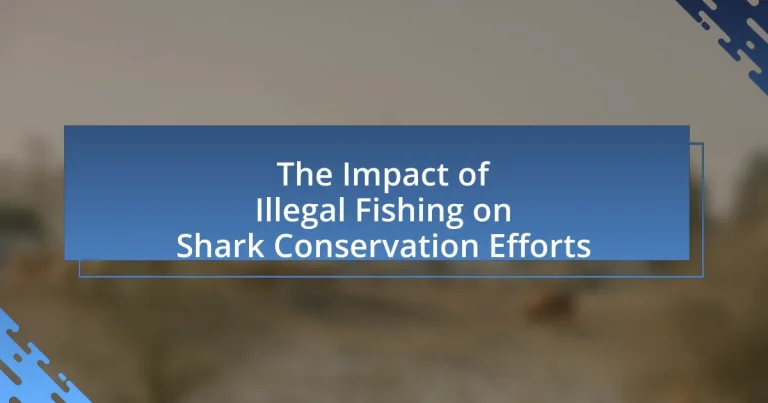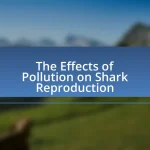The article examines the significant impact of illegal fishing on shark conservation efforts, highlighting how this practice depletes shark populations and disrupts marine ecosystems. It details the specific shark species most affected, such as hammerhead, whale, and great white sharks, and discusses the ecological roles sharks play as apex predators. The article also explores the legal frameworks surrounding shark conservation, the socio-economic consequences of illegal fishing on coastal communities, and the challenges faced by conservationists. Additionally, it outlines strategies for combating illegal fishing, the role of technology in monitoring, and the importance of community engagement and NGO partnerships in enhancing conservation initiatives.
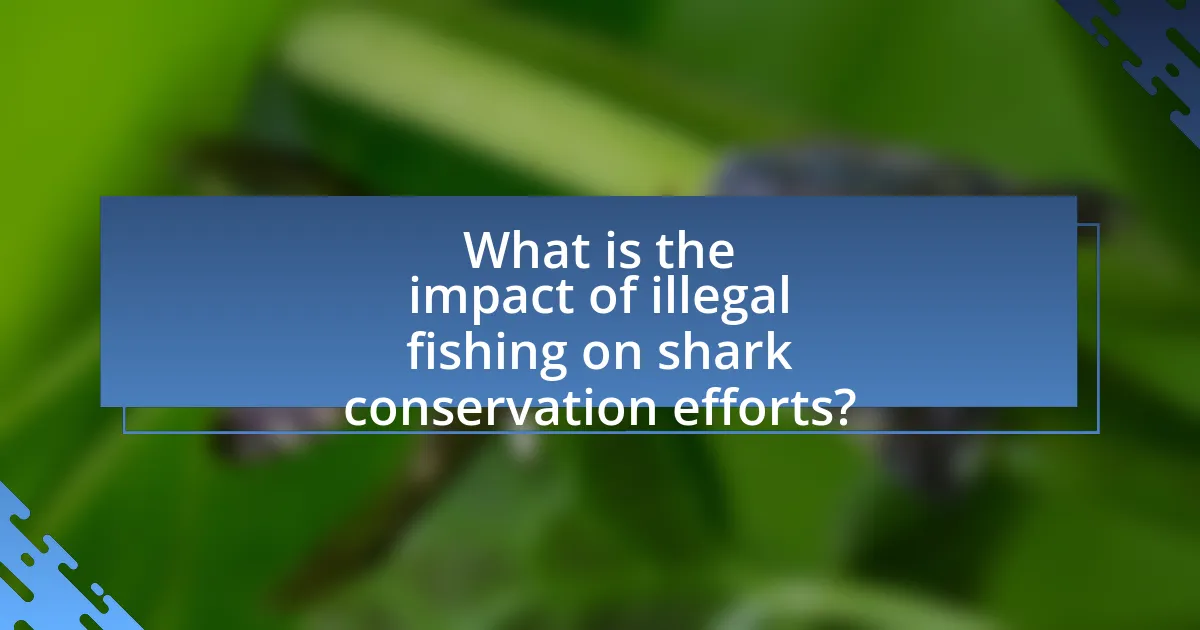
What is the impact of illegal fishing on shark conservation efforts?
Illegal fishing significantly undermines shark conservation efforts by depleting shark populations and disrupting marine ecosystems. This illegal activity often targets vulnerable shark species, leading to increased mortality rates that hinder population recovery. For instance, the United Nations Food and Agriculture Organization reported that illegal, unreported, and unregulated (IUU) fishing accounts for up to 30% of global fish catches, which includes many shark species. Consequently, the decline in shark numbers affects the balance of marine ecosystems, as sharks play a crucial role as apex predators. This disruption can lead to overpopulation of prey species, further destabilizing marine environments and complicating conservation initiatives aimed at protecting sharks and their habitats.
How does illegal fishing affect shark populations?
Illegal fishing significantly reduces shark populations by targeting them directly and disrupting their ecosystems. This practice often involves the use of unregulated fishing methods that capture sharks indiscriminately, leading to overfishing and a decline in their numbers. For instance, studies indicate that illegal fishing contributes to the depletion of shark species, with some populations declining by over 90% in certain regions due to unsustainable practices. Additionally, the removal of sharks from marine ecosystems can destabilize food webs, further threatening their survival and the health of the ocean environment.
What are the specific species of sharks most affected by illegal fishing?
The specific species of sharks most affected by illegal fishing include the hammerhead shark, the whale shark, and the great white shark. Hammerhead sharks are particularly targeted for their fins, which are highly valued in the shark fin trade. Whale sharks, the largest fish species, face threats from illegal fishing due to their slow reproductive rates and high demand for their meat and fins. Great white sharks are also heavily impacted, as they are often caught accidentally in illegal fishing operations or targeted for their fins. These species are listed as vulnerable or endangered by the International Union for Conservation of Nature (IUCN), highlighting the urgent need for conservation efforts to combat illegal fishing practices.
How does illegal fishing contribute to the decline of shark populations?
Illegal fishing significantly contributes to the decline of shark populations by removing large numbers of sharks from their ecosystems, often exceeding sustainable limits. This practice disrupts the balance of marine ecosystems, as sharks play a crucial role as apex predators, maintaining the health of fish populations and overall biodiversity. According to a study published in the journal “Marine Policy,” illegal fishing accounts for up to 30% of the global catch of sharks, leading to severe population declines in various species. The lack of regulation and enforcement in illegal fishing exacerbates this issue, as it allows for the targeting of vulnerable shark species, further threatening their survival.
Why is shark conservation important?
Shark conservation is important because sharks play a crucial role in maintaining the health of marine ecosystems. As apex predators, they help regulate the populations of other marine species, which in turn supports biodiversity and the overall balance of oceanic environments. Research indicates that the decline of shark populations can lead to overpopulation of prey species, resulting in detrimental effects on coral reefs and seagrass beds, which are vital for carbon sequestration and coastal protection. For instance, a study published in the journal “Nature” found that the removal of sharks from ecosystems can lead to a 50% decline in coral reef health due to unchecked herbivore populations. Thus, conserving sharks is essential for sustaining marine biodiversity and ecosystem stability.
What ecological roles do sharks play in marine ecosystems?
Sharks play crucial ecological roles in marine ecosystems as apex predators, helping to maintain the balance of marine life. By preying on various species, sharks regulate fish populations, which in turn supports the health of coral reefs and seagrass beds. For instance, studies have shown that the decline of shark populations can lead to an overabundance of smaller fish species, resulting in the degradation of these vital habitats. Additionally, sharks contribute to the overall biodiversity of marine ecosystems, as their presence influences the behavior and distribution of prey species, promoting a more balanced and resilient ecosystem.
How does the decline of shark populations impact marine biodiversity?
The decline of shark populations negatively impacts marine biodiversity by disrupting the balance of marine ecosystems. Sharks are apex predators, and their reduction leads to an increase in the populations of smaller fish and invertebrates, which can result in overgrazing of seagrass and coral reefs. This imbalance can diminish habitat complexity and reduce the overall health of marine environments. Research indicates that the loss of sharks can lead to a decline in species richness and abundance, as evidenced by studies showing that areas with fewer sharks experience significant shifts in community structure, ultimately threatening the resilience of marine ecosystems.
What are the legal frameworks surrounding shark conservation?
The legal frameworks surrounding shark conservation primarily include international agreements, national laws, and regional fisheries management organizations. Key international agreements such as the Convention on International Trade in Endangered Species of Wild Fauna and Flora (CITES) regulate the trade of endangered shark species, while the United Nations Convention on the Law of the Sea (UNCLOS) provides guidelines for the conservation and management of marine resources, including sharks. National laws vary by country but often include specific regulations aimed at protecting shark populations, such as bans on shark finning and restrictions on fishing quotas. Additionally, regional fisheries management organizations, like the Western and Central Pacific Fisheries Commission (WCPFC), implement measures to ensure sustainable shark fishing practices. These frameworks collectively aim to mitigate the impact of illegal fishing on shark populations and promote their conservation.
What international agreements exist to protect sharks?
Several international agreements exist to protect sharks, including the Convention on International Trade in Endangered Species of Wild Fauna and Flora (CITES), the Convention on Migratory Species (CMS), and the Food and Agriculture Organization’s (FAO) International Plan of Action for the Conservation and Management of Sharks (IPOA-Sharks). CITES regulates international trade of shark species listed in its appendices, while CMS aims to conserve migratory species, including sharks, through cooperative agreements among countries. The IPOA-Sharks provides a framework for countries to develop national plans to manage shark populations sustainably. These agreements collectively contribute to the global effort to mitigate the impact of illegal fishing on shark conservation.
How effective are current laws in combating illegal fishing?
Current laws are moderately effective in combating illegal fishing, but enforcement challenges and loopholes limit their impact. For instance, the United Nations Food and Agriculture Organization reported that illegal, unreported, and unregulated fishing accounts for up to 26 million tons of fish caught annually, undermining conservation efforts. Additionally, regional fisheries management organizations often lack the resources and authority to enforce regulations effectively, leading to continued illegal activities. Therefore, while laws exist, their effectiveness is significantly hampered by enforcement issues and insufficient international cooperation.
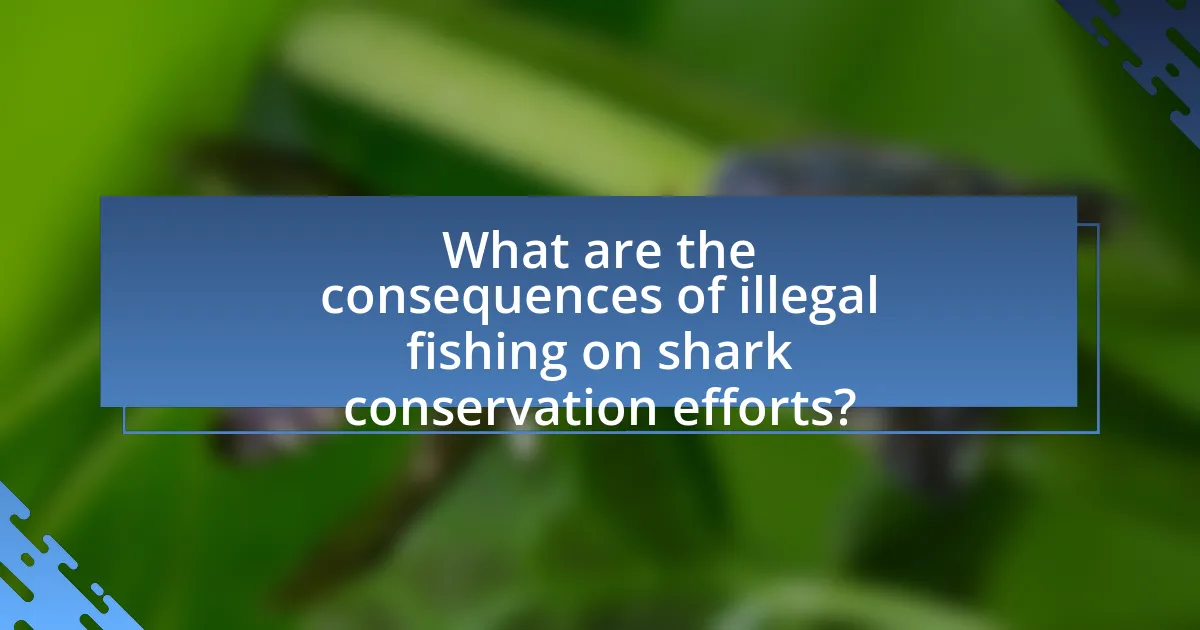
What are the consequences of illegal fishing on shark conservation efforts?
Illegal fishing significantly undermines shark conservation efforts by depleting shark populations and disrupting marine ecosystems. This illegal activity often targets endangered shark species, leading to a decline in their numbers, which can result in the collapse of local marine biodiversity. According to the International Union for Conservation of Nature (IUCN), over 30% of shark species are threatened with extinction, largely due to unsustainable fishing practices, including illegal fishing. Furthermore, illegal fishing practices often bypass regulations designed to protect sharks, such as size limits and seasonal closures, exacerbating the challenges faced by conservation initiatives. The loss of sharks disrupts the balance of marine ecosystems, as they play a crucial role as apex predators, maintaining the health of coral reefs and fish populations.
How does illegal fishing undermine conservation initiatives?
Illegal fishing undermines conservation initiatives by depleting fish populations and disrupting marine ecosystems, which are critical for the recovery of endangered species like sharks. This illegal activity often targets species that are already vulnerable, leading to a decline in their numbers and hindering efforts to restore their populations. For instance, a study published in the journal “Marine Policy” found that illegal, unreported, and unregulated fishing accounts for up to 30% of the global catch, significantly impacting the sustainability of marine resources. Consequently, conservation programs that rely on stable fish populations to support ecological balance and biodiversity are rendered ineffective, as the illegal practices directly counteract the goals of these initiatives.
What challenges do conservationists face due to illegal fishing?
Conservationists face significant challenges due to illegal fishing, primarily including the depletion of shark populations and disruption of marine ecosystems. Illegal fishing practices often target endangered shark species, leading to a decline in their numbers, which is critical for maintaining ecological balance. For instance, studies indicate that overfishing has contributed to a 70% decline in some shark populations over the past few decades. Additionally, illegal fishing undermines regulatory frameworks and conservation efforts, making it difficult for conservationists to implement effective management strategies. The lack of enforcement and monitoring in many regions further exacerbates these challenges, as illegal activities continue unchecked, threatening both biodiversity and the livelihoods of communities dependent on sustainable fishing practices.
How does illegal fishing affect funding for shark conservation projects?
Illegal fishing significantly reduces funding for shark conservation projects by depleting shark populations and undermining the effectiveness of conservation efforts. When illegal fishing occurs, it leads to a decline in shark numbers, which in turn diminishes the perceived need for conservation funding as stakeholders may believe that the species is less at risk. Additionally, the loss of sharks disrupts marine ecosystems, making it harder to justify investments in conservation initiatives. According to a report by the World Wildlife Fund, illegal fishing can result in economic losses of up to $23 billion annually, diverting resources away from legitimate conservation programs and creating a cycle of underfunding and ecological degradation.
What are the socio-economic impacts of illegal fishing on coastal communities?
Illegal fishing significantly undermines the socio-economic stability of coastal communities by depleting fish stocks, which are vital for local livelihoods. This depletion leads to reduced income for fishermen and their families, as well as increased competition for dwindling resources, resulting in heightened poverty levels. According to the Food and Agriculture Organization, illegal fishing can account for up to 30% of the global catch, exacerbating food insecurity and threatening the sustainability of local fisheries. Furthermore, the loss of fish populations disrupts local economies reliant on fishing-related activities, such as processing and tourism, ultimately leading to job losses and economic decline in these communities.
How does illegal fishing influence local economies dependent on sustainable fishing?
Illegal fishing negatively impacts local economies that rely on sustainable fishing by depleting fish stocks and undermining livelihoods. When illegal fishing occurs, it reduces the availability of fish for legal fishers, leading to decreased catches and income for those who depend on sustainable practices. For instance, a study by the Food and Agriculture Organization (FAO) indicates that illegal, unreported, and unregulated (IUU) fishing can account for up to 30% of global fish catches, which directly threatens the economic stability of communities that engage in sustainable fishing. This depletion not only affects immediate income but also jeopardizes long-term sustainability and food security, as overfishing can lead to ecosystem collapse, further harming local economies.
What are the implications for food security in regions affected by illegal fishing?
Illegal fishing significantly undermines food security in affected regions by depleting fish stocks that local communities rely on for sustenance and income. This depletion leads to reduced availability of affordable protein sources, exacerbating malnutrition and food scarcity, particularly in coastal areas where fishing is a primary livelihood. According to the Food and Agriculture Organization (FAO), illegal, unreported, and unregulated (IUU) fishing accounts for up to 26 million tons of fish caught annually, which directly impacts local fisheries and the communities dependent on them. Furthermore, the economic losses from illegal fishing can reach billions of dollars, hindering investment in sustainable practices and further threatening food security.
What role do enforcement and monitoring play in shark conservation?
Enforcement and monitoring are critical components of shark conservation as they help deter illegal fishing activities and ensure compliance with regulations. Effective enforcement measures, such as patrols and inspections, reduce poaching and overfishing, which are significant threats to shark populations. Monitoring, through data collection and analysis, provides insights into shark populations and fishing practices, enabling adaptive management strategies. For instance, the implementation of the Shark Conservation Act in the United States has led to increased enforcement against shark finning, resulting in a decline in illegal shark fishing activities. These combined efforts are essential for maintaining healthy shark populations and preserving marine ecosystems.
How can technology aid in monitoring illegal fishing activities?
Technology aids in monitoring illegal fishing activities through the use of satellite tracking, drones, and automated identification systems. Satellite tracking allows for real-time monitoring of fishing vessels, enabling authorities to detect unauthorized activities in protected areas. Drones provide aerial surveillance, offering a cost-effective method to cover large oceanic regions and identify illegal fishing operations. Automated identification systems, such as AIS (Automatic Identification System), help in tracking vessel movements and ensuring compliance with fishing regulations. According to a study published in the journal “Marine Policy,” the integration of these technologies has led to a significant reduction in illegal fishing incidents, demonstrating their effectiveness in protecting marine ecosystems and supporting conservation efforts.
What are best practices for enforcing fishing regulations?
Best practices for enforcing fishing regulations include implementing regular patrols and surveillance in fishing areas to deter illegal activities. Effective enforcement relies on collaboration between government agencies, local communities, and non-governmental organizations to share information and resources. For instance, the use of technology such as satellite monitoring and drones has proven effective in tracking illegal fishing vessels, as evidenced by the Global Fishing Watch initiative, which utilizes satellite data to monitor fishing activities globally. Additionally, establishing clear penalties for violations and promoting community awareness about the importance of sustainable fishing practices can enhance compliance with regulations. These strategies collectively contribute to the protection of marine ecosystems and support shark conservation efforts by reducing illegal fishing activities that threaten shark populations.
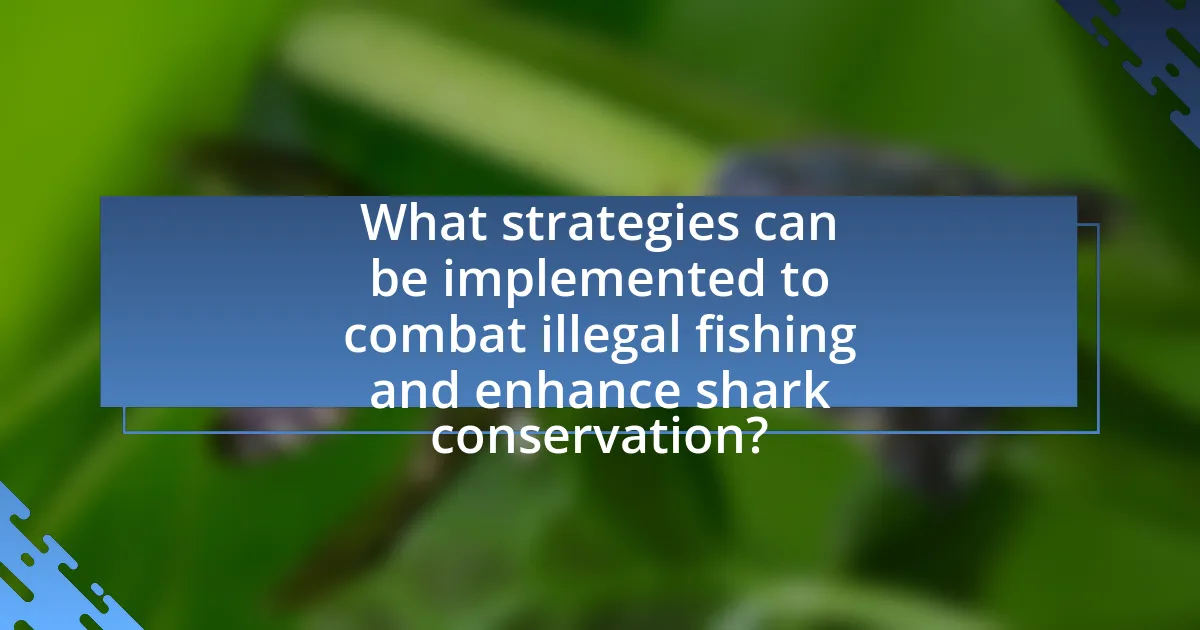
What strategies can be implemented to combat illegal fishing and enhance shark conservation?
To combat illegal fishing and enhance shark conservation, implementing stricter enforcement of fishing regulations is essential. This can be achieved through increased patrols and surveillance in critical habitats, utilizing technologies such as satellite monitoring and drones to detect illegal activities. For instance, the Global Fishing Watch initiative uses satellite data to track fishing vessels, helping authorities identify and respond to illegal fishing in real-time. Additionally, establishing marine protected areas (MPAs) can provide safe havens for shark populations, allowing them to recover from overfishing. Research indicates that MPAs can lead to a 20-50% increase in shark populations within their boundaries. Furthermore, engaging local communities in conservation efforts through education and sustainable fishing practices can foster stewardship and reduce reliance on illegal fishing. These strategies collectively contribute to the protection of shark species and the sustainability of marine ecosystems.
How can community engagement improve shark conservation efforts?
Community engagement can significantly improve shark conservation efforts by fostering local stewardship and awareness. When communities are actively involved in conservation initiatives, they are more likely to understand the ecological importance of sharks and the threats posed by illegal fishing. For instance, programs that educate local fishermen about sustainable practices can reduce illegal fishing activities, as seen in the case of the Bahamas, where community-led initiatives have led to a 50% reduction in illegal fishing incidents. Engaging local populations also encourages the reporting of illegal activities, enhancing enforcement efforts and protecting shark populations.
What educational programs can raise awareness about the impacts of illegal fishing?
Educational programs that can raise awareness about the impacts of illegal fishing include community workshops, school curricula focused on marine conservation, and public awareness campaigns. Community workshops often involve local fishermen and stakeholders, providing them with information on sustainable fishing practices and the ecological consequences of illegal fishing. School curricula can integrate lessons on marine ecosystems, emphasizing the role of sharks and the threats posed by illegal fishing, thereby educating future generations. Public awareness campaigns utilize social media, documentaries, and informational materials to reach a broader audience, highlighting statistics such as the estimated 20-30 million sharks killed annually due to illegal fishing practices, which threaten biodiversity and disrupt marine ecosystems.
How can local communities be incentivized to protect shark populations?
Local communities can be incentivized to protect shark populations through financial rewards, education programs, and sustainable tourism initiatives. Financial rewards can include payments for ecosystem services, where communities receive compensation for conserving shark habitats, which has been shown to improve local engagement in conservation efforts. Education programs that raise awareness about the ecological importance of sharks can foster a sense of stewardship, as evidenced by initiatives like the Shark Guardian program, which has successfully increased local participation in conservation. Additionally, sustainable tourism initiatives, such as shark diving experiences, can provide economic benefits while promoting the protection of sharks, as seen in places like the Bahamas, where shark tourism has become a significant source of income for local communities.
What role do NGOs play in shark conservation?
NGOs play a crucial role in shark conservation by advocating for policies that protect shark populations and their habitats. They engage in research to gather data on shark species, monitor illegal fishing activities, and raise public awareness about the threats sharks face. For instance, organizations like Oceana and the Shark Trust have successfully campaigned for the implementation of fishing regulations and marine protected areas, which are essential for the sustainability of shark populations. Additionally, NGOs often collaborate with governments and local communities to promote sustainable fishing practices, thereby directly addressing the impact of illegal fishing on shark conservation efforts.
How can partnerships between NGOs and governments enhance conservation efforts?
Partnerships between NGOs and governments can enhance conservation efforts by combining resources, expertise, and influence to create more effective strategies for protecting ecosystems. For instance, NGOs often possess specialized knowledge and grassroots connections that can inform government policies, while governments can provide regulatory frameworks and funding necessary for large-scale conservation initiatives. A notable example is the collaboration between the World Wildlife Fund (WWF) and various governments to combat illegal fishing, which has led to the establishment of marine protected areas and stricter enforcement of fishing regulations. This synergy not only amplifies the impact of conservation measures but also fosters community engagement and compliance, ultimately leading to more sustainable outcomes for shark populations and marine biodiversity.
What successful case studies exist for combating illegal fishing through NGO initiatives?
Successful case studies for combating illegal fishing through NGO initiatives include the efforts of the Sea Shepherd Conservation Society, which has effectively disrupted illegal fishing activities through direct action campaigns and legal advocacy. For instance, their Operation Icefish campaign targeted illegal toothfish fishing in the Southern Ocean, resulting in the seizure of illegal vessels and the arrest of crew members, thereby protecting marine biodiversity. Another example is the work of Oceana, which has successfully lobbied for stronger fisheries management policies in various countries, leading to the establishment of marine protected areas that help safeguard shark populations from illegal fishing practices. These initiatives demonstrate the effectiveness of NGOs in addressing illegal fishing and contributing to shark conservation efforts.
What practical steps can individuals take to support shark conservation?
Individuals can support shark conservation by advocating for sustainable fishing practices and reducing demand for shark products. Engaging in community awareness campaigns can educate others about the importance of sharks in marine ecosystems, as they play a crucial role in maintaining the balance of ocean health. Supporting organizations dedicated to shark conservation, such as the Shark Trust or Oceana, can also amplify efforts against illegal fishing, which threatens shark populations. Additionally, individuals can choose to consume seafood that is certified sustainable, thereby reducing pressure on shark species. According to the World Wildlife Fund, sustainable fishing practices can help mitigate the impact of illegal fishing on shark populations, promoting healthier marine environments.
How can consumers make informed choices to reduce demand for illegally caught fish?
Consumers can make informed choices to reduce demand for illegally caught fish by prioritizing seafood that is certified sustainable and traceable. Research indicates that seafood labeled with certifications from organizations like the Marine Stewardship Council (MSC) or the Aquaculture Stewardship Council (ASC) is less likely to be sourced from illegal fishing operations. Additionally, consumers can utilize apps and resources such as the Seafood Watch program, which provides recommendations on sustainable seafood choices based on regional availability. By actively seeking out these certified products and supporting retailers that commit to sustainable sourcing, consumers can significantly diminish the market for illegally caught fish, thereby aiding shark conservation efforts and promoting healthier marine ecosystems.
What actions can individuals take to advocate for stronger shark conservation policies?
Individuals can advocate for stronger shark conservation policies by engaging in awareness campaigns, supporting legislation, and participating in local conservation efforts. Engaging in awareness campaigns involves educating the public about the threats sharks face, such as illegal fishing, which has led to a significant decline in shark populations; for instance, studies indicate that over 100 million sharks are killed annually due to fishing activities. Supporting legislation includes lobbying for laws that protect shark species and their habitats, such as the Shark Conservation Act, which aims to prevent shark finning. Participating in local conservation efforts can involve joining organizations dedicated to marine conservation, volunteering for beach clean-ups, or promoting sustainable fishing practices within communities. These actions collectively contribute to a stronger advocacy for shark conservation policies.
